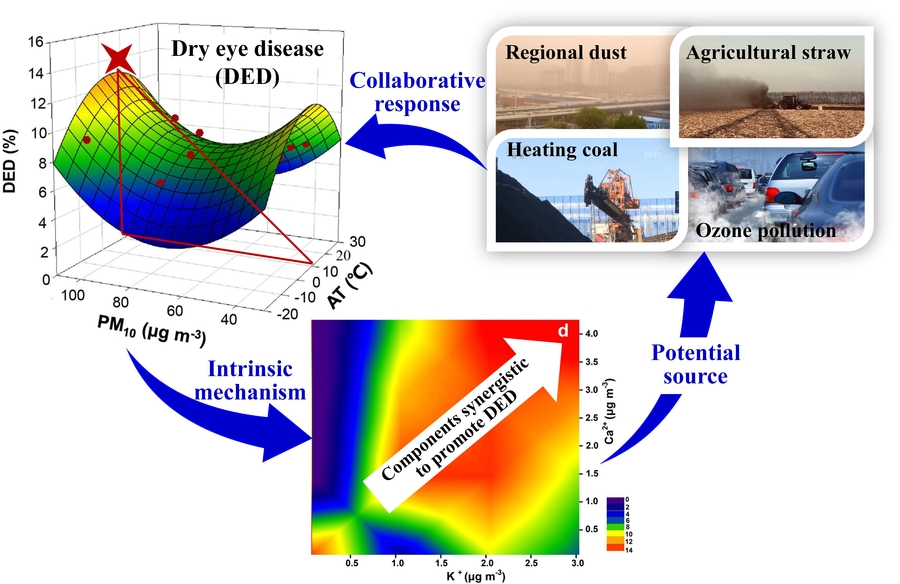Can your bright eye to be shined under the heavy air pollution?
KNOXVILLE, TN, October 18, 2023 /24-7PressRelease/ — This is the first to explore the potential relationship between DED and air pollution and meteorological conditions in cold region of Northeast China. The incidence of DED is positively correlated with PM10, CO, O3, air pressure, air temperature and wind speed. The combined impacts of PM10, NO2, air pressure and air temperature are stronger. This study provides a reference for air pollution prevention and climate control, highlighting the importance of coupling study for drug development and risk prediction.
2020 Chinese expert consensus points out that: DED is a chronic ocular surface disease caused by multiple factors, which is caused by the instability of tear film or the imbalance of the ocular surface microenvironment caused by the abnormal quality, quantity and dynamics of tears, and can be accompanied by ocular surface inflammatory response, tissue damage and nerve abnormalities, resulting in a variety of ocular discomfort symptoms and/or visual dysfunction. DED is the first common eye disease in ophthalmology clinics after myopia, and has become a public health problem and raising increased concern around the world. Common symptoms of DED include dryness, foreign body sensation, burning sensation, itching, photophobia, red eyes, blurred vision, vision fluctuations, etc. Severe DED can lead to corneal ulcers, perforation, and even blindness. It can even cause sleep disorders, anxiety, and depression. At the global scale, the prevalence of dry eye varies greatly, up to 50%. In China, about 360 million people are affected by DED, and the rate is rising by 10% every year. However, due to the regional characteristics of individual physical level (age, gender, hormone), allergic diseases and environmental factors (climate, weather, pollution), the prevalence of dry eye varies greatly.
Climate change has led to the intensification of extreme weather and air pollution, which is seriously threatening human health and has become an important unstable factor restricting the sustainable development of China’s society. Northeast China, a heavy industry base, central heating area and straw open burning area in high latitude and cold region, has increased the complexity of air pollution with significant increasing of the number of haze days in the past 50 years. So far, the impacts of atmospheric pollutants and meteorological conditions on DED in the cold regions are rarely reported. Under the prospect of coordinated reduction in pollutant and carbon emissions, the response degree and possible mechanism of cooperative governance of atmospheric particulate matter and ozone to regional DED are still unclear, which increases the uncertainty of the potential environmental risks and control sources of DED.
Based on this, recently, a team from Prof. Chengwei Lu of the Department of Ophthalmology, The First Hospital of Jilin University and Prof. Weiwei Chen of Northeast Institute of Geography and Agroecology, Chinese Academy of Sciences, following the breakthrough of cross-disciplinary research on air pollution, climate change and allergic conjunctivitis, once again conducted the cross study on DED in cold regions of China. The results is published “Light: Science & Applications” under the title of “Impacts of air pollution and meteorological conditions on dry eye disease among residents in a northeastern Chinese metropolis: A six-year crossover study in a cold region”.
The author collected and analyzed outpatient data, air pollution data and meteorological data of DED incidence in Changchun, a core city in northeast China, in the past 6 years. Using comprehensive statistical methods (correlation, regression and machine learning), this study for the first time clarified the quantitative correlation between air pollutants and climate factors in the cold region of Northeast China on DED, as well as the potential impact mechanism. This will contribute to a more rational allocation of strained resources for the control and prevention of disease and health. The study found that the frequency of DED was higher in March and April, followed by January, August and October in the cold region of Northeast China. Monofactor analysis revealed that air pollutants (PM10, O3, CO) and meteorological factors (air temperature: AT; Air pressure: AP; Wind speed: WS) was positively associated with DED, suggesting that these factors can worsen DED. Multifactor analysis revealed that air pollutants (PM10, NO2) and meteorological parameters (AT, AP) have the strongest synergistic influence on DED. For the first time, the relationship between the chemical composition of atmospheric particulate matter and DED was investigated, and the potential emission sources (i.e., dust and ozone precursors) affecting DED in Northeast China were proposed, as well as the importance of coordinated mitigation policies (air pollution and climate change). However, with the frequent regional dust events this year, the incidence of DED may gradually increase in the future. The response of DED to air pollution and climate change in Northeast China and its possible mechanism were studied. On the one hand, the specific chemical components of DED caused by air pollutants in cold regions were clarified, which could provide theoretical basis for drug development and drug sensitivity of air pollution-related DED in the future. On the other hand, it provides a specific reference for the formulation of air environment standards in the cold region of Northeast China based on ocular surface health and the coordination control of air pollution.
The authors collected and analyzed the data of outpatient DED incidence, air pollution and meteorological factors from Changchun city in recent six years, for the first time, the quantitative relationship between air pollutants and meteorological factors on DED in cold region and the potential impact mechanism were clarified using comprehensive statistical methods (correlation, regression and machine learning). This study will contribute to a more rational allocation of strained resources for the control and prevention of disease and health. It was found that the frequency of DED was higher in March and April, followed by January, August and October. From a univariate perspective, air pollutants (PM10, O3, CO) and meteorological factors (temperature: at; Pressure: AP; Wind Speed: WS) were positively associated with DED, suggesting that these factors can promote or worsen DED symptoms. From the perspective of multiple factors, air pollutants (PM10, NO2) and meteorological parameters (AT, AP) had the strongest synergistic effect on DED. The relationship between the chemical composition of atmospheric particulate matter and DED was studied for the first time, and the potential emission sources (i.e. , dust, fugitive dust and ozone precursors) affecting DED in Northeast China were proposed, and the importance of coordinated mitigation policies (air pollution and climate change) were highlighted . We also sketched possible mechanism of DED to air pollution and meteorological factors. Furthermore, the association of specific chemical components of atmospheric particulate and DED in cold region was clarified, which could provide theoretical basis for drug development and drug sensitivity of air pollution-related DED. And also it provides a specific reference for the formulation of air environment standards on ocular surface health and the coordination control of air pollution. Based on these results, with the frequent occurrence of dust events in the region this year, the incidence of DED may gradually increase in the future.
References
DOI
10.1038/s41377-023-01207-1
Original Source URL
https://doi.org/10.1038/s41377-023-01207-1
Funding information
This work was supported by the Funds from the Key Research Program of Frontier Sciences, Chinese Academy of Sciences (QYZDB-SSW-DQC045); Technology Development Plan of Jilin Province (20210101279JC), National Natural Science Foundation of China (82171023)
Contact
Cheng-Wei Lu
The Department of Ophthalmology, The First Hospital of Jilin University, Changchun 130021, China, lcwchina800@jlu.edu.cn
About Light: Science & Applications
The Light: Science & Applications will primarily publish new research results in cutting-edge and emerging topics in optics and photonics, as well as covering traditional topics in optical engineering. The journal will publish original articles and reviews that are of high quality, high interest and far-reaching consequence.
Chuanlink Innovations, where revolutionary ideas meet their true potential. Our name, rooted in the essence of transmission and connection, reflects our commitment to fostering innovation and facilitating the journey of ideas from inception to realization.
Related Link:
http://chuanlink-innovations.com
—
For the original version of this press release, please visit 24-7PressRelease.com here





